night·mare [nahyt-mair]
noun
- a terrifying dream in which the dreamer experiences feelings of helplessness, extreme anxiety, sorrow, etc.
- a condition, thought, or experience suggestive of a nightmare: the nightmare of his years in prison.
- reflective of the process of trying to design an optic for the 300 AAC Blackout.
I got this from Websters, really. OK, maybe not all of it, but you have to admit that the definitions of “extreme anxiety” and “helplessness” fit pretty well, right?
There aren’t many 300 AAC Blackout specific optics on the market and I can guess why. Imagine trying to design a reticle that can accommodate the incredible variety of ballistic performance of that round. As we talked about a few weeks ago in the article about 300 Blackout Ammunition and Reloading, there is no “standard” ballistic performance profile. You can do pretty much whatever you want in a broad range of subsonic to supersonic performance. And therein lies the challenge for the optics gurus. How do you design a ballistic drop compensation reticle to account for… infinity plus one?
Wonky ballistics
Before going into the specifics of these two optics, let’s take a look at the ballistic challenges they have to overcome – all in the same reticle. For purposes of the trajectories shown here, let’s assume a zero yard zero, and we’ll use two common and “representative” projectiles and “standard” velocities. For the supersonic load, we’ll show the flight path of a Barnes TAC-TX 110-grain bullet. As a side note, Barnes just released a 120-grain version of this bullet – I can’t wait to try it. I’ll assume a velocity of 2,500 feet per second. For the subsonic load, we’ll use the classic 220 grain Sierra Matchking and assume a traveling speed of 1,050 feet per second.
The purpose of the “zero yard zero” is to compare the absolute, unadjusted flight paths of the two rounds. Basically, we’re looking at shooting each round exactly parallel to the ground to see how it falls over distance.
| Yards | Barnes 110 grain TAC-TX, 2,500 fps | Sierra MatchKing 220 grain, 1,050 fps |
| 0 | 0.00 | 0.00 |
| 50 | -0.72 | -3.98 |
| 100 | -3.00 | -16.14 |
| 150 | -7.05 | -36.78 |
| 200 | -13.13 | -66.20 |
| 250 | -21.52 | -104.71 |
| 300 | -32.57 | -152.59 |
| 350 | -46.68 | -210.13 |
| 400 | -64.31 | -277.63 |
| 450 | -86.02 | -355.36 |
| 500 | -112.41 | -443.63 |
As you can see, the brick, I mean subsonic round, falls at about four times the rate of the supersonic. That’s a lot to account for. The idea behind a common reticle is to design it for the supersonic round and figure out a couple of realistic hold points for a short range trajectories of the subsonic round.
As we’ll look at in more detail this week, two premium optics companies have done just that. Trijicon and Leupold have each developed outstanding 300 AAC Blackout solutions. In my words, not theirs, the two options are not really comparable. They’re more like apples and oranges. Do you want applesauce or orange juice? More specifically, do you want adjustable precision or simplicity and speed?
The Trijicon offering borrows from the company’s ACOG line. It’s a fixed power optic that you adjust once, then shoot. And shoot. And shoot.
The Leupold offering is more of a scope tinkerer’s dream. With variable magnification and lots of fine lines in the reticle, you can get it to do whatever you want, out to very long ranges.
Let’s take a closer look at what each has to offer. One thing that both have in common is that they have boiled the ballistic ocean to two options at the extreme ends of 300 Blackout performance. The idea behind both the Trijicon and Leupold optics is that they design a dual reticle, with one-half mapped to supersonic projectiles in the 110-grain vicinity and the other mapped to subsonics in the 220-grain vicinity. If you want to use stuff in the middle ranges, it’s up to you to do some trial and error to map the reticle marks to specific ranges. On the plus side, at shorter and more reasonable ranges, it won’t really matter if you’re shooting 110, 125 or even 135-grain projectiles. That will only become significant past a couple hundred yards or so, so don’t get too concerned.
Trijicon TA33-C 3×30 ACOG 300 AAC Blackout
The Trijicon 300 AAC Blackout optic, like most other ACOGs, is a fixed power magnification design. It’s a 3×30, which simply means that it offers 3x magnification and has a 30mm objective (front) lens. And these choices are what drives my observations of the “fast and efficient” option. No zoom controls, generous eye relief and enough magnification to clearly see and index targets hundreds of yards away, it’s simple. It’s designed to use the Bindon aiming concept. In Trijicon’s words, “Human vision is based upon a binocular (two eyes) presentation of visual evidence to the brain.” In plain English, that means keep both eyes open. Your brain does magic brain stuff and you see your target with reticle superimposed. The reason is that the Trijicon uses a bright reticle, which allows your brain to merge the target image from your outside eye with the aim point visible through your “scope” eye.
Like other siblings in the ACOG family, this model has a dual illuminated reticle. As all the military door kickers had existing orders for the popular amber colored reticle, I chose the green option to get an in-stock unit in my hands faster. You can also order this optic with red reticle illumination. Choice of color turned out to be an insignificant issue. The green reticle shows up plenty in broad daylight. In low-light conditions, the visibility is even better.
The reticle is simple, yet has both hold point and basic ranging tools. You zero your supersonic round at 100 yards dead in the cross-hairs, then use the hash marks for 300, 400, 500 and 600 yards. The 200-yard hold point is actually the bottom of the cross-hair bar.
For subsonic rounds, there are two solid diamonds: one above the 300-yard supersonic hold point and the other resting on the 400-yard hold point. These are 50 and 100 yard holds for a standard subsonic round.
I zeroed the Trijicon at 100 yards with 110-grain supersonic ammunition. Then I popped in subsonic rounds put the 50-yard whole point directly over the bulls-eye on a 50-yard target. The very first shot hit dead center, so that was encouraging. Additional shooting proved the hold points were dead on with my loads.
With a little shopping, you can find this optic for just under $1,100.
Leupold Mark 4 MR/T 1.5-5x20mm
The Leupold Mark 4 is a variable scope with the 300 AAC Blackout specific reticle in the first focal plane. This means that the reticle will grow and shrink as you adjust magnification. At low-magnification levels, the inverted horseshoe acts like a red dot, especially with illumination on a high level. At higher magnification levels, you have a finely granulated reticle that provides moving target lead information, range estimation tools and holdover points for supersonic and subsonic loads.
The optic itself is all Leupold. It’s solid and all movements operate like clockwork. Flip up scope caps are provided that mount with rubber friction cups. Unlike others on the market, these stay in place until you want to take them off. The magnification dial is easy to rotate with one hand while keeping a firing grip on the rifle. The windage and elevation dials offer quiet, smooth and positive click adjustments, with each click representing ½ Minute of Angle (MOA) or ½ inch at 100 yards. One nice touch for windage and elevation adjustments is an engraved directional indicator that is visible from the back, telling you which way to twist to the dials to move the point of impact up, down, left or right.
Let’s talk about the reticle for a minute. Like the Trijicon, it’s engineered to show hold points for both supersonic and subsonic 300 AAC Blackout loads. Leupold’s approach is to split the reticle horizontally – the right side of center shows supersonic information while the left indicates subsonic. Just in case you forget, there is small and subtle hare engraved in the lower right and a tortoise on the lower left. The hold points are all relative to a 100-yard zero on the center dot for a supersonic cartridge.
The supersonic (right side) markings indicate hold points from 100 to 900 yards with marks at each 100-yard increment. Each horizontal indicator bar is sized to represent an 18-inch wide target at the respective yardage length. For example, if the 400-yard hash mark appears to be the same width as an object you know to be about 18 inches wide, then that object is 400 yards down range. It’s a quick and easy ranging system.
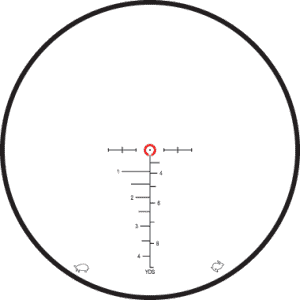
Leupold takes a different approach with the reticle: subsonic on the left and supersonic on the right.
On the subsonic (left) side, there are hash marks from 100 to 400 yards with a line at each 100-yard increment in that range. There is not a 50-yard indicator per se, but between the center dot and bottom of the inverted horseshoe, you can do a quick test to find short range impact points for your chosen subsonic load.
One other reticle feature to note. On either side of the center dot are horizontal lines with hash mark indicators that correspond to hold points to lead targets moving at 5, 10 and 15 miles per hour respectively.
The reticle is illuminated with the inverted horseshoe and center dot lighting up in red. A left side knob offers seven different light levels for low light or daylight conditions. One handy feature is that between each intensity setting on the dial is an “off” position. You don’t have to spin the dial all the way back to zero each time you turn illumination on or off. Just keep is one click from your most commonly used setting, give it a click in either direction and you’re good to go.
Street price on the Leupold is just about $1,400.
Closing thoughts
This is not one of those “which one is better” situations. Both of these offerings are premium optics solutions – the brand reputations speak for themselves. After using both for a period of time, it became clear that this is, in fact, an apples and oranges situation.
The Leupold optic offers precision at longer range. While the markings are a bit optimistic, (400 yards for a subsonic 300 Blackout is quite a lob), I guess that’s no different than the speedometer on your Caddy going up to 160 miles per hour. You can lower magnification and turn on the illumination for quick close range performance, but I think this optic really shines when you are engaging targets out past 100 yards. The glass is crystal clear as you would expect from Leupold, and you’ll be able to shoot very, very precisely.
The Trijicon is a fast no-brainer solution. With fixed 3x magnification, there’s nothing to fiddle with. Raise your rifle, open your eyes and go. The two eyes open concept works great unless you’re cross-eye dominant and establishing aim is fast. The reticle offers enough granularity to hit reasonable sized targets out to a few hundred yards. For a tactical or home defense rifle, I do like the “always” on reticle lighting. In the daytime, the fiber optic tube makes the reticle glow brightly and in low-light conditions, a tritium lamp lights it up. No batteries to run down and no switches to operate – it’s just on.
The budget only allows me to send a check for one of these, and I’m genuinely torn. You can’t go wrong with either.
[one_half]
[/one_half]
[one_half_last]
[/one_half_last]
[one_half]
[/one_half]

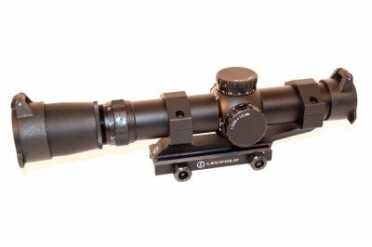

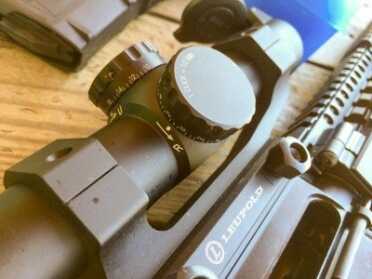
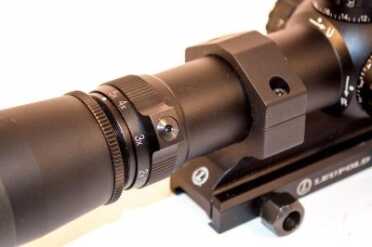
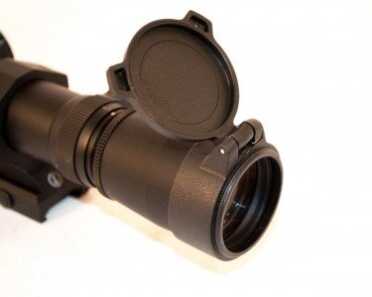
Predetermined, I’ll only utilize a affordable setting along with actually zero our weapon whenever to the certain rounded My spouse and i prefer to search for using.
Thanks a lot…
Try a Super Sniper tactical scope, they have from $299 models well up to Leo Mk4 prices and many designs. Buddy shoots an AR platform in 300 black out and so far uses the 16x version and has his hand loads pretty nailed as well as limited box round he has available..
Both are too pricy. Unless being used by a police or military unit as a dedicated suppressed close range sniper weapon I doubt many will spend up for this cartridge. Nice for high end hog hunters and income advantaged gadget geeks but the average 300 blackout guy with an AR is more concerned with CQB & home defense, and bolt gun owners doing close range hunting want in at a lower price point. I could be wrong but this is my thinking.
Agreed, I’ll just use a cheap scope and zero my rifle each time for the particular round I plan to hunt with.
While both have sub- super-sonic hold marks; put a suppressor on and they’re both unreliable.
I didn’t find that at all in my testing. The rifle I was using is suppressed with a SilencerCo SWR Specwar 7.62. There was a small one-time change in point of impact adding the silencer, but once the scopes were zeroed one time, they worked just as they were supposed to. Any BDR optic will want ammo in its defined range, so as long as you stick to a reasonable range within 115 grain supersonic and 220 grain subsonic performance windows, you’ll be fine.